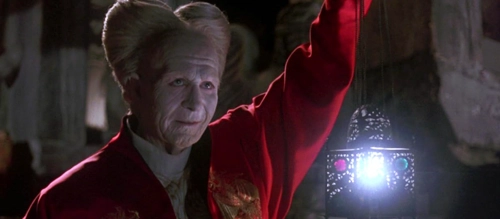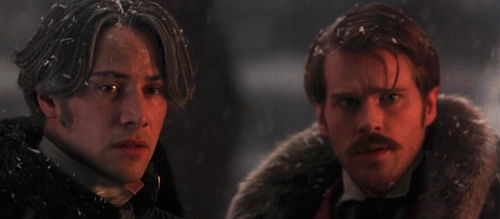Bram Stoker’s Dracula (1992) Review

Bram Stoker’s Dracula (1992)
Director: Francis Ford Coppola
Screenwriter: James V. Hart
Starring: Gary Oldman, Winona Ryder, Keanu Reeves, Sadie Frost, Richard E. Grant, Cary Elwes, and Anthony Hopkins
Bram Stoker’s “Dracula” is one of the most popular and well-known works in English literature, a seminal gothic horror novel that dominated our conception of the vampire well into the 20th century. Its mythos and its iconography has long intrigued those willing to engage with it, including some of the most notable names in Hollywood and filmmakers from all over the world. Each of the major players involved with realising the story on the big screen have had a hand in shaping and expanding the tradition defined by Stoker, leading to some of the most iconic images in cinema. There is, of course, Nosferatu A Symphony of Horror, the 1922 silent film directed by F. W. Murnau, Universal’s 1931 adaptation starring Bela Lugosi, and the 1958 Hammer horror film starring Christopher Lee, which was one of the first depictions of the character with fangs. In all, there are over 200 film adaptations of Stoker’s classic tale.
In the summer of 1992, renowned director Francis Ford Coppola began work on his own interpretation of “Dracula”. “We know what our biggest problem is,” he told a room of collaborators recorded for a behind-the-scenes featurette. “Our biggest problem is, ‘why did they go to all this trouble to make that same story again?’ We’ve seen all of this stuff.” It seems he knew what his biggest obstacle would be in bringing such an instantly recognizable story to the big screen.
When Bram Stoker’s Dracula released in the autumn of 1992, the answer Coppola gave to that question seemed to be: because it looks absolutely breathtaking. Over thirty years later, Coppola’s version remains a feat of visual storytelling, a fever dream of eroticism and horror, that managed to re-define, once again, the image of the vampire on film. Its reputation as a prestige horror film opened the door for countless others that were made in its image in the mid to late-1990s and most certainly influenced the 1994 adaptation of Anne Rice’s 1976 novel, Interview with the Vampire. Coppola’s confidence and command over his craft, coupled with Eiko Ishioka’s outstanding costume design, makes Bram Stoker’s Dracula one of the most visually inspiring screen adaptations of Stoker’s work and remains the only Dracula film to win any Academy Awards (for Sound Effects Editing, Makeup, and Costume Design).
Screenwriter James V. Hart keeps Stoker’s novel mostly intact and makes an attempt to preserve its epistolary structure. As in the novel, a good portion of the film is presented through a series of letters, diary entries and newspaper articles, all written by our main cast of characters, from the young solicitor Jonathan Harker (Keanu Reeves), who writes letters to his fiancé Mina Murray (Winona Ryder), while he journeys to Count Dracula’s (Gary Oldman’s) castle in Transylvania to arrange for a series of real estate acquisitions, and keeps a diary of his eventual imprisonment and escape, to Dr. Jack Seward (Richard E. Grant), who records his thoughts on a phonograph while treating patients at his insane asylum.
While the film doesn’t attempt to reinvent the wheel as far as its story goes, Francis Ford Coppola makes significant changes to the character of Dracula himself, turning him into a far more tragic and sympathetic figure than he is in the novel and in many previous adaptations. The film opens with a flashback to 1462, as Vlad Dracula sets off to battle. He survives, but his enemies send false word of his death to his wife, Elisabeta (also played by Winona Ryder), who throws herself off the castle and to her death. When Dracula finds out, he is overcome with grief and rage, and is furious with the priest for suggesting his wife’s soul is damned because she died by suicide. Dracula renounces God and forsakes his faith, intent on becoming a creature of the night to avenge his love. He sticks a sword into the cross, and blood pours from it, a river of crimson flows toward his feet.
The idea of the vampire as a type of antihero had existed before this film, but giving Dracula a tragic backstory and a motivation to be united with his one true love gifted the film a romantic touch that doesn’t exist in the novel.
As Dracula, Gary Oldman displays incredible versatility. His commitment to the character is constant amid the many forms Dracula takes throughout, such as a wolfman and a man-sized bat. The top notch hair and make up design aids him in these changes. He believably plays a pale white and wrinkled old man with hairy palms who terrorizes Jonathan, as well as a dashing young man with piercing blue eyes and long, curly hair. Oldman is theatrical when he needs to be, and then heartbreakingly vulnerable. Bram Stoker’s Dracula was Oldman’s first American film, and while he had a reputation for playing villainous roles, this portrayal highlights his range. There are certainly some wacky moments in this movie, like when Dracula scales the side of his castle, but Oldman finds a way to keep the character grounded.

As far as the other performances go, Anthony Hopkins as the vampire hunter Abraham Van Helsing is a surprising and welcome source of comedic delight in the film, while Cary Elwes, Richard E. Grant and Billy Campbell (as three of Lucy’s (Sadie Frost’s) suitors) add strong performances to the ensemble.
The elephant in the room is Keanu Reeves. At the time of release, Reeves was taken to task for his abysmal English accent and rather stiff and awkward performance as Jonathan Harker. And it is true that Reeves seems uncomfortable in this role – his cadence is at times robotic. Reeves is an incredibly magnetic screen presence and, unfortunately, this film does not play to his strengths as an actor. Ironically, Reeves being uncomfortable almost works in his favor in several scenes, given how buttoned up, restrained and horrified his character is most of the time, but any perceived shortcomings are overcome by the strong supporting cast anyway.
Bram Stoker’s Dracula is full of striking and hypnotic imagery, like champagne bubbles blurring into blood platelets, or Dracula’s eyes appearing in the sky as Jonathan makes his way by train to Transylvania. The use of matte backgrounds, forced perspective, and rear projection create a dreamlike aesthetic, as if you’re inside a watercolor painting. These old Hollywood techniques, coupled with the fact that a lot of the outdoor scenes were filmed on soundstages, creates the illusion that this is a much older film. Coppola famously refused to use any CGI, which forced Roman Coppola, who led the visual effects, to get very creative. That effort paid off. There are hints of Michael Powell in this film and even the Hammer horror films in regards to how the film uses color. Film history in general seems to be something Coppola wanted to reference, given that he acknowledges the birth of moviemaking by having the count and Mina meet in London at a screening of the cinematograph.
The costume design is the true star of this film, though. Eiko Ishioka’s designs are so singular, so original, and divorced from anything you would normally associate with vampires on screen. The costumes are both of the time and completely fantastical, more focused on conveying character than sticking to historical fact. Lucy’s outfits are sheer and flowing, out the shoulder and revealing, to showcase how free she is from society’s expectations, while Mina’s look is far more restrained and covered up, the ideal Victorian woman. Dracula’s armor in the beginning of the film is a definite highlight (dark red with ribbing that looks like exposed muscle), as are the blue glasses he wears while in London.
If there’s one thing working against this movie it’s that it is stuck firmly in its Victorian sensibilities. Coppola very much plays up the anxieties around sex and desire during the 19th century, particularly the effect on good Christian women. It’s a film that turns you on, while horrifying you at the same time. Because of this, it doesn’t deviate very much from the source material. It isn’t interested in subverting Stoker’s work, instead choosing to double down on it. Besides its choice to give Dracula more human qualities, he is still a foreign invader, intent on corrupting good, God-fearing people, on seducing us to the dark side. He is a man without faith, and the film doesn’t make an attempt to question that. Lucy is promiscuous, so she must be punished. Mina must not because she doesn’t give in to temptation. In the end, the status quo remains.
Bram Stoker’s Dracula may give vampires a whole new look, but it is still the same old story. If you’re looking for a vampire movie that adds something new to Stoker’s iconic work, something that challenges it, this might not be the movie for you. But, if you love the novel and you’re looking for some old-fashioned gothic horror, this might be the perfect thing to sink your teeth into.
Score: 21/24

